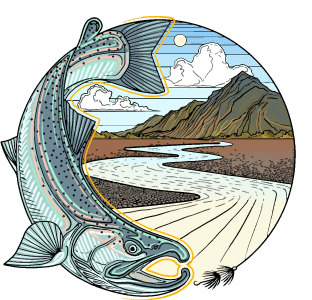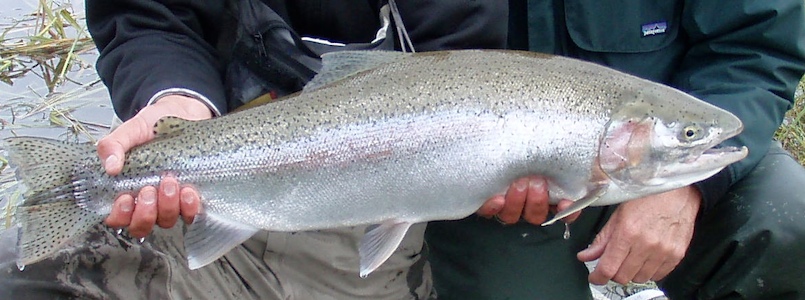As the spawning season progresses into September, the early sockeye start to die and the rainbow trout can often be seen tearing at their carcasses, rolling about to rip off long strips of flesh. As the die-off continues, flesh flies in ginger, off-white, and two-toned with pinkinsh or orangy hues are often the key to success. Try Bandit Leeches, Egg Sucking Flesh Flies, and AFG Rubber Leg Articulated Flesh Fly. As with early season, there will be some dollies or char mixed in among the spawners as well, so be prepared for a little variety.
The first coho of the year begin to show up in August, and by September the run is in full swing. Many anglers say silvers are their favorite salmon. Their size, acrobatic fighting style, and willingness to take a fly make them an ideal fish to chase on a fly rod. Coho are responsive to many different groups of flies and the angler-in-the-know will have a wide selection, including top water patterns like Popper Wogs, streamers such as the Chartreuse/White Clouser and Pink Half-n-Half, and dead-drift flies such as Hareball Leeches and Coho Kryptonite.
By October, much of the fishing is over for the year as the salmon have mostly died off following the spawn. The first snows of the year begin to fall in October, and by the second week, temperatures rarely exceed 40° during the day. The one shining light of the late September-early October period, however, is the trophy rainbow trout season. This is mostly focused in Bristol Bay and the Kenai. The late season represents the last opportunity for the trout to forage for the long winter, and they feed ravenously on the decaying flesh of the spawned-out salmon carcasses. Large articulated flesh flies and "dead" beads are the go-to combinations for rainbows during the late season. Bandit Leeches, Lady Flesh, and the String o Flesh can get you into the trout of a lifetime!
October is the Month of the Steelhead in the Kodiak archipelago and the Kenai Peninsula. As mentioned earlier, these sea-going rainbow trout are primarily fall-run in these two regions. Most systems hold moderate runs of fish, often numbering 200 adults or fewer. However, some rivers receive runs numbering in the thousands of fish. Most notable for its exceptional fishery is the Karluk River on Kodiak Island, which hosts Alaska's second largest run of steelhead behind the mighty Situk of Southeast. With a recent ten-year average count of 8,000 returning adults this jewel is certainly among the world's top steelhead-producing systems. Fall-run fish can be caught on a large selection of flies, but some of our favorites include the Thunder MOAL, the Sandy Kandy, and the Fish Taco. Be sure to have a wide selection of Glo-bugs and beads on hand as well, as these fall rockets often have a taste for eggs.






